

Automaton infernal devices. Surface Design + Inspiration. Green Tarot Shift Dress. We Love Fairground. Downtomarsgirl.files.wordpress.com/2009/07/ltd-100-placement-digital-print-shift-dress-by-para-manko. Wp-content/uploads/2012/05/Aqua-Spirit-I-Digital-Print-Dress-2-501x1024. Www.polyvore.com/cgi/img-thing%3F.out%3Djpg%26size%3Dl%26tid%3D44460742. Www.polyvore.com/cgi/img-thing%3F.out%3Djpg%26size%3Dl%26tid%3D29022299. Products — PIA BOUTIQUE. 0 items · Check out Collections Frill Dresses 23 products Frill Tops 18 products SS14' by Pia Naera 45 products Winter 2013 28 products Accessories 0 products Home / Collections Search About Us Contact Shipping & Returns Copyright © 2014 Pia Boutique.

PayPal Mastercard Visa. Fairground Clothing. Surface Design + Inspiration. Mary Katrantzou Fall 2010 Ready-to-Wear Collection on Style.com: Runway Review. Portraits of Madame de Pompadour, the paintings of Fragonard and Nattier—what could the frills and curlicues of the rococo have to do with the digital print revolution?
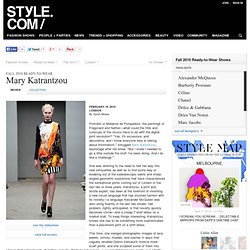
"Yes, it's excessive, and decorative, and I know everyone else is talking about minimalism," shrugged Mary Katrantzou, backstage after her show. "But I knew I needed to go a little outside the stuff I've been doing. And I do like a challenge. " She was referring to the need to feel her way into new silhouettes as well as to find some way of breaking out of the kaleidoscopic swirls and sharp-angled geometric explosions that have characterized the sensational prints coming out of London in the last two or three years.
Katrantzou, a print and textile expert, has been at the forefront of inventing a new visual language that has stunned fashion with its novelty—a language Alexander McQueen was also using fluently in his last two shows. Black Crystal Print Silk Tulip Skirt by MARY KATRANTZOU. Neck (water spirit) The Nyx/Nixie (German: Nix/Nixie/Nyx, Norwegian: Nøkk or plural: Nøkken) are shapeshifting water spirits who usually appear in human form.
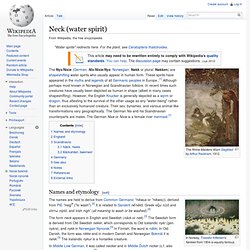
These spirits have appeared in the myths and legends of all Germanic peoples in Europe.,[1] Although perhaps most known in Norwegian and Scandinavian folklore. In recent times such creatures have usually been depicted as human in shape (albeit in many cases shapeshifting). However, the English Knucker is generally depicted as a wyrm or dragon, thus attesting to the survival of the other usage as any "water-being" rather than an exclusively humanoid creature. Their sex, bynames, and various animal-like transformations vary geographically. The German Nix and his Scandinavian counterparts are males.
The names are held to derive from Common Germanic *nikwus or *nikwis(i), derived from PIE *neigw ("to wash").[2] It is related to Sanskrit nḗnēkti, Greek νίζω nízō and νίπτω níptō, and Irish nigh' (all meaning to wash or be washed).[3] The Endicott Studio Journal of Mythic Arts, Summer 2003. Back of the Cereal Box: Baubo Siren Revisited. Rave. Rave culture originated mostly from acid house music parties in the mid-to-late 1980s in the Chicago area in the United States.[1] After Chicago house artists began experiencing overseas success, it quickly spread to the United Kingdom, Central Europe, Australia and the rest of the United States.[2][3] Congo Natty, Congo Dubz, Sounds UNder Pressure.
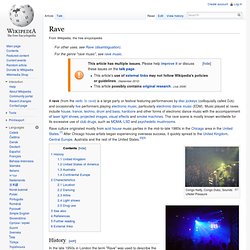
Acid-house-party.jpg (620×600) Klaxons - magick. Back of the Cereal Box: Secrets of the Starbucks Mermaid. I swear I’m not fixating on mythological creatures, previous posts being evidence to the contrary.

That being said, this post chiefly concerns mermaids and coffee. Ivana Pilja POSI+TIVE MAGAZINE > Fashionclash Maastricht 2012 > Fashionclash. Centaur. Harpy. From New World Encyclopedia A medieval depiction of a Harpy as a bird-woman.
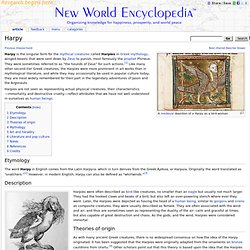
Harpy is the singular form for the mythical creatures called Harpies in Greek mythology, winged-beasts that were sent down by Zeus to punish, most famously the prophet Phineus. They were sometimes referred to as "the hounds of Zeus" for such actions.[1] Like many other second-tier Greek creatures, the Harpies were more prominent in art works than in mythological literature, and while they may occasionally be used in popular culture today, they are most widely remembered for their part in the legendary adventures of Jason and the Argonauts.
Harpies are not seen as representing actual physical creatures, their characteristics—immortality and destructive cruelty—reflect attributes that we have not well understood in ourselves as human beings. Etymology The word Harpy in English comes from the Latin Harpyia, which in turn derives from the Greek Άρπυια, or Harpuia. Sphinx. Perhaps the first sphinx, Queen Hetepheres II from the fourth dynasty (Cairo Museum) A sphinx (Greek: Σφίγξ /sphinx/.

Bœotian: Φίξ /Phix) is a mythical creature with, as a minimum, the body of a lion and a human head. In Greek tradition, it has the haunches of a lion, sometimes with the wings of a great bird, and the face of a human. Snake. The snake's head ram - an attribute of gods with horns and fecundating symbol of strength and fertility.
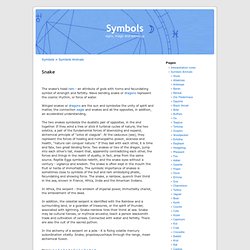
Wave bending snake or dragons represent the cosmic rhythm, or force of water. File:The Hunt of the Unicorn Tapestry 5.jpg. BRANKOPOPOVICBLOG: Ivana Pilja at FASHIONCLASH Maastricht 2012. Ivana Pilja from Serbia is coming again to FASHIONCLASH Maastricht!
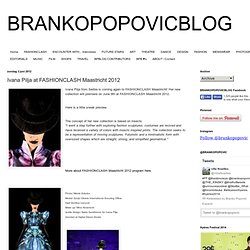
Her new collection will premiere on June 9th at FASHIONCLASH Maastricht 2012.Here is a little sneak preview.The concept of her new collection is based on insects. "I went a step further with exploring fashion sculptures; costumes are revived and have received a variety of colors with insects inspired prints. The collection seeks to be a representation of moving sculptures. Futuristic and a minimalistic form with oversized shapes which are straight, strong, and simplified geometrical. "More about FASHIONCLASH Maastricht 2012 program here. Griffin. Pliny the Elder [1st century CE] (Natural History, Book 10, 70): The griffin with its terrible hooked beak Pliny judges to be fabulous.

Isidore of Seville [7th century CE] (Etymologies, Book 12, 2:17): The griffin is both a feathered animal and a quadruped; its body is like that of a lion, but it has wings and the face of an eagle. Griffins are hostile to horses and attack any man they see. Bartholomaeus Anglicus [13th century CE] (De proprietatibus rerum, book 12): A griffin is accounted among flying things (Deut. xiiii.) and there the Gloss saith, that the griffin is four-footed, and like to the eagle in head and in wings, and is like to the lion in the other parts of the body. And dwelleth in those hills that are called Hyperborean, and are most enemies to horses and men, and grieveth them most, and layeth in his nest a stone that hight Smaragdus against venomous beasts of the mountain.